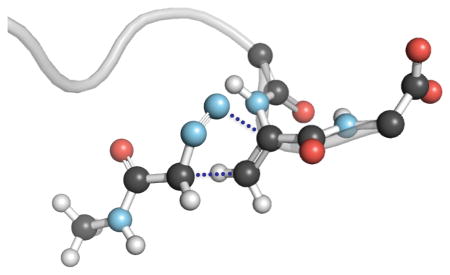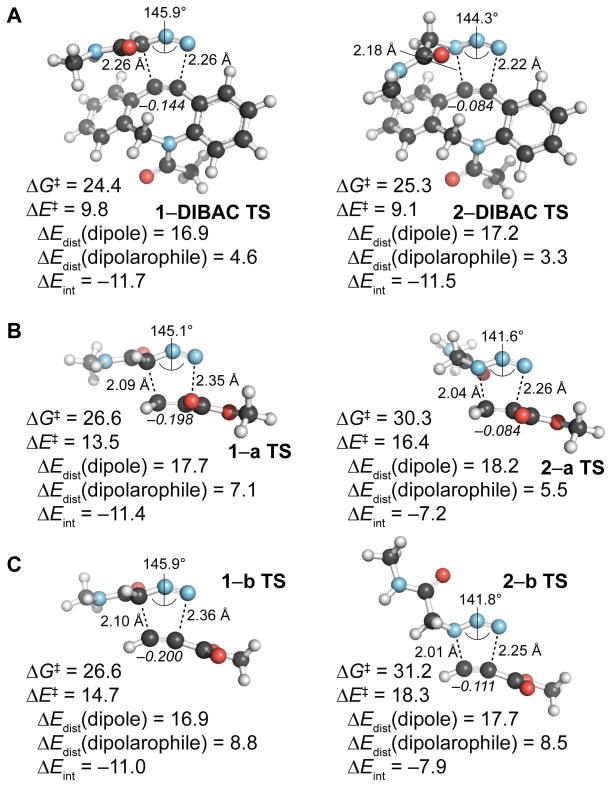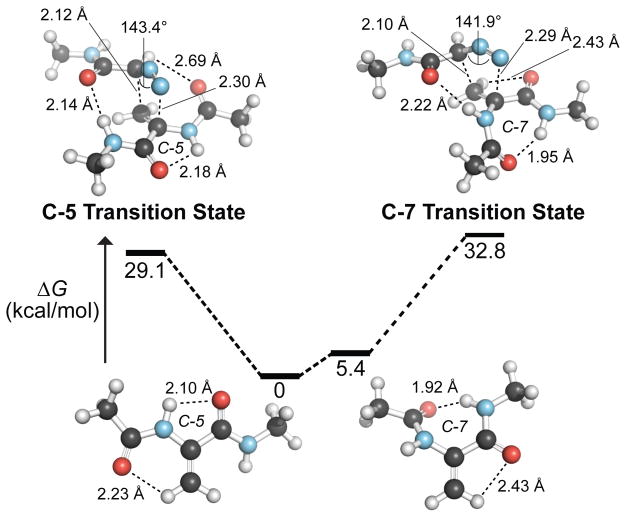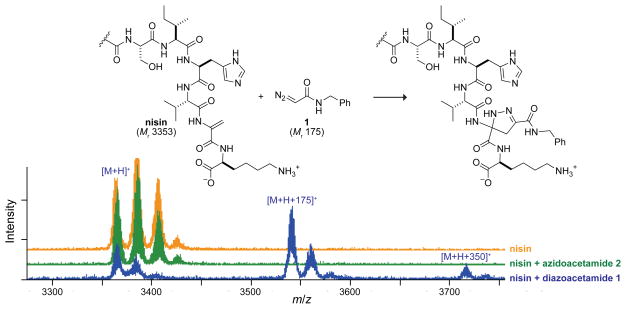Abstract
The diazo group has untapped utility in chemical biology. The tolerance of stabilized diazo groups to cellular metabolism is comparable to that of azido groups. Yet, chemoselectivity has been elusive, as both groups undergo 1,3-dipolar cycloadditions with strained alkynes. Removing strain and tuning dipolarophile electronics yields diazo group-selective 1,3-dipolar cycloadditions that can be performed in the presence of an azido group. For example, diazoacetamide but not its azido congener react with dehydroalanine residues, as in the natural product nisin.
Graphical Abstract

Recent developments1 in the Huisgen azide–alkyne 1,3-dipolar cycloaddition2 have led to an apogee of interest in the azido group. Now, azides dominate the landscape of chemoselective reactions in chemical biology.3,4 Similar but distinct reactivity makes the diazo group an attractive alternative, especially when multicomponent selectivity is desirable.
The diazo group has been of tremendous utility to the field of organic chemistry for well over a century.5 This functional group is capable of varied reactivity, including alkylation, carbene generation, nucleophilic addition, homologation, and ring expansions.5d A stabilized diazo group can also serve as a reporter for chemical biology, undergoing cycloadditions with the cyclooctynes now in common use in strain-promoted azide–alkyne cycloadditions (SPAACs) (Scheme 1).6
Scheme 1.
(Left) The 1,3-dipolar cycloaddition of a 1:1 mixture of diazoacetamide 1 and azidoacetamide 2 with a strained dipolarophile (R=CH2CH2NH2) was not selective. (Right) The 1,3-dipolar cycloaddition with unstrained dipolarophiles was selective for the diazo compound. Conditions: 1:1 CH3CN/H2O; ≤ 72 h; ambient temperature.
With its compact size, facile preparation, and stability in an aqueous environment, a pendant diazoacetamide group is well-suited for biological investigations.7 This type of diazo group is capable of faster cycloadditions with common cyclooctynes than is its azido analog.8 Nevertheless, the reactivity of these two groups is redundant, and the overlap encouraged us to search for a cycloaddition that is selective for only one.
We sought a reaction that not only differentiated the reactivity of diazo and azido groups, but also was compatible with physiological conditions. Known strategies exist for diazo-specific reactions in aqueous conditions, such as metal-carbenoid additions/insertions,9 esterifications,10 and carbonyl additions,11 but each of these processes has drawbacks that prevent broad application in a biological context. Frustrated by the lack of selectivity generated with SPAAC-type reactions between azido and diazo groups, we sought a simple cycloaddition reaction that would favor the characteristics of a diazo group.
In theory, orthogonal cycloadditions could be generated through modulation of the electronics of the reacting partners. In normal electron demand (NED) cycloadditions, the dipole has relatively high nucleophilicity; in inverse electron demand (IED) cycloadditions, the dipole has relatively high electrophilicity.12 Selectivity from electronic demand has been attained using a diversity of azides13 as well as nitrones.14 Here we report a strategy to differentiate a diazo group and analogous azido group through chemoselective NED cycloadditions.
Diazo compounds undergo uncatalyzed cycloadditions with numerous dipolarophiles other than strained alkynes.5b,6,8,15 The decreased HOMO–LUMO gap imparted by strain enables efficient reactions with azides. For example, electron-rich azides react more rapidly than do electron-deficient azides in a cycloaddition with DIBAC.13,16 DIBAC also reacts faster than do other cyclooctynes with the diazoacetamide functionality.6
To search for preferential reactivity of the more electron-rich diazo group over the azido group, we performed a competition experiment. One equivalent of both a diazoacetamide (1) and its azide analog (2) were combined with an equivalent of DIBAC and allowed to react until the octyne was consumed completely (Scheme 1). Despite the ~5-fold faster rate of the diazo group, which was consistent with calculated values of ΔG‡ (Figure 1), a significant percentage of the azido group reacted as well. The modest rate difference did not produce selectivity.
Figure 1.
Computational analysis of cycloadditions with N-methyl-2-diazoacetamide and N-methyl-2-azidoacetamide. Optimized geometries, activation energies, distortion-interactions energies, and changes in dipolarophile charge (italics) were calculated at the M06-2X/6-31+G(2d,p) level of theory. Energies (kcal/mol) and NBO charges on dipolarophiles (italics) include solvation corrections (water) on gas-phase geometries using IEFPCM model (radii=UFF).
From this precedent, we reevaluated the need for strain to effect 1,3-dipolar cycloadditions with diazoacetamide 1. Specifically, we hypothesized that we could replace strain with electronic activation. In this modality, dipolarophiles possessing a lower energy LUMO, generated from bond polarization of adjacent electron-withdrawing groups—rather than through strain—would complement the higher nucleophilicity of diazo compounds.
We first examined ethyl propiolate b and its alkene analog, ethyl acrylate a, under conditions identical to those in the competition reaction with DIBAC. In this case, selective reactivity for the diazoacetamide over the azide was observed, even in the presence of a five-fold excess of dipolarophile (Scheme 1). These experimental results are consistent with a computational analysis, which suggest that the cycloaddition of the diazo group proceeds by a transition state (TS) of lower ΔG‡ (Figure 1). Although the dipoles of both 1 and 2 favor NED cycloadditions, the greater nucleophilicity of the diazo group of 1 leads to chemoselectivity. Cycloaddition of the diazo group appears to be less synchronous, as its TS exhibits greater transfer of charge from the dipole to the dipolarophile as well as a longer terminal N···C bond distance (Figure 1). Notably, the relative reactivity of the diazo group is amplified in aqueous conditions (Figure S3),6,8 which favor the more polar TS of the diazo group.17
Ethyl acrylate (a) reacted more quickly than did ethyl propiolate (b) with diazoacetamide 1 (k = 1.6 × 10−3 M−1s−1 and k = 5.8 × 10−4 M−1s−1, respectively). This result was surprising, as previous reports had suggested similar reaction rates for alkenes and alkynes, despite different FMO energies.18 The difference that we observed is likely due to a smaller distortion energy (ΔEdist) for dipolarophile a, along with a slightly more favorable interaction energy (ΔEint) (Figure 1).19 Although alkynes are easier to bend than are alkenes, an alkyne must be bent to a larger degree to reach a TS geometry.20 The difference in dipolarophile distortion energy of 1.7 kcal/mol is similar to the value of 2.1 kcal/mol reported previously for the cycloadditions of diazomethane with ethylene and acetylene calculated at the B3LYP/6-31G(d) level of theory.18 These results are consistent with the smaller HOMO–LUMO gap of alkenes relative to alkynes.
In light of the faster rates observed for the alkene,20 we focused our attention on ethyl acrylate and related alkenyl compounds.21 Upon examining the reaction kinetics of a carbonyl series of electron-deficient alkenes, we verified that the rate of the reaction was dependent upon the electron-withdrawing capabilities of the substituent. Cycloadditions with a variety of dipolarophiles (a–f, see Supporting Information) produced rate constants comparable to those of early SPAACs (that is, k ≈ 10−2 M−1s−1).4b,22
We next sought to challenge the selectivity in a simple context. To do so, we synthesized a compact molecule containing both a diazo group and an azido group. We reacted diazo azide 3 with an excess of ethyl acrylate a. The results were gratifying—the diazo group reacted completely to form the pyrazoline product 3–a while the azido group remained intact and free for subsequent functionalization or derivation (Scheme 2).
Scheme 2.
Competition for a dipolarophile by a diazo group and azido group in the same molecule. The reaction was selective for the diazo group. Conditions: CH3CN/H2O 1:1; 24 h.
Lastly, we considered applications of this chemoselective process within the arena of chemical biology. Acrylate esters are too reactive for most biological applications.6 The tempered reactivity of acrylamides, however, enables their metabolic incorporation into biomolecules.23 For example, the 2-acetamidoacrylamide group in dehydroalanine (Dha) is the product of a post-translational elimination of H2O from serine or H2S from cysteine.24 The alkenyl group of dehydroalanine is in conjugation with both an amide carbonyl group and an amide nitrogen. We hypothesized that this functionality might be a good substrate for reaction with a diazo group.
We first tested the reactivity of diazoacetamide 1 with an O-acyl derivative of Dha, methyl 2-acetamidoacrylate. The reaction rate exceeded that of previously tested alkenes by an order of magnitude, proceeding with k = 6.7 × 10−2 M−1s−1. This enhanced rate was recapitulated in computational investigations, as calculated free energies of activation with a 2-acetamido-N-methylacrylamide model system were similar to those predicted for N-alkyl acrylamides (Figure 2 and Table 1S). The Curtin–Hammett principle predicts a ΔG‡ of 29.1 kcal/mol for the lower energy C-5 conformation, but enforcement of the C-7 conformation would provide a lower overall ΔG‡ of 27.4 kcal/mol.
Figure 2.
Computational analysis of the cycloaddition of 2-acetamido-N-methylacrylamide with N-methyl-2-diazoacetamide. Optimized geometries and free energies were calculated at the M06-2X/6-31+G(2d,p) level of theory. Energies include solvation corrections (water) on gas-phase geometries using IEFPCM model (radii=UFF).
Inspired by the reactivity of diazoacetamide 1 with 2-acetamido-N-methylacrylamide, we investigated its reactivity with a natural product. Dehydroalanine is found in lantibiotics, including the peptide antibiotic nisin.25 Nisin is well suited to test the biological relevance of the cycloaddition with the diazo group, as it contains two Dha residues and one dehydrodrobutyrine (Dhb) residue (which is derived from threonine) along with a myriad of common peptidic functional groups (Figure S5 in the Supporting Information).
We began our work with nisin by assessing the ability of diazoacetamide 1 to label a purified sample of the natural product. After 16 h, most of the peptide had experienced a single cycloaddition, and some had reacted twice (Figure 3). Notably, the full mass of the diazo compound had been added to the peptide, ruling out the possibility of reaction by esterification, as is possible with diazo groups.10
Figure 3.
MALDI–TOF spectra of the products of the cycloaddition of nisin with N-benzyl-2-diazoacetamide (1) and N-benzyl-2-azidoacetamide (2). Conditions: 10 mM sodium phosphate buffer (pH 7.3), 16 h, ambient temperature.
Finally, we tested the utility of this cycloaddition for natural-product discovery. To do so, we reacted a crude mixture of denatured protein solids containing 2.5% w/w nisin with diazoacetamide–biotin conjugate. We observed a change in mass expected for the labeling of nisin by cycloaddition (Figure S33 in the Supporting Information). No reaction was observed with the analogous azidoacetamide–biotin conjugate.
In conclusion, we report on a simple means to differentiate the reactivity of an azido group and a diazo group. Whereas strain is necessary to obtain useful cycloaddition rates with azides, electronic activation of alkenes allows for rapid reactivity with diazoacetamides. This insight enables cycloadditions to dehydroalanine, such as that in nisin. To our knowledge, this example is the first of a cycloaddition to a natural amino-acid residue. The chemoselectivity of the diazo–Dha cycloaddition could aid in applications of known natural products and the discovery of new ones.
Supplementary Material
Acknowledgments
This work was supported by Grant R01 GM044783 (NIH) and made use of the National Magnetic Resonance Facility at Madison, which is supported by Grant P41 GM103399 (NIH). The purchase of the Bruker microflex™ LRF in 2015 was funded by the Bender gift to the Department of Chemistry. Computational resources were supported in part by Grant CHE-0840494 (NSF). We are grateful to K. A. Andersen and C. L. Jenkins (University of Wisconsin–Madison) for contributive discussions.
Footnotes
The authors declare no competing financial interest.
ASSOCIATED CONTENT
Supporting Information. Synthetic methods and analytical data along with additional computational data, Cartesian coordinates, energies, and imaginary frequencies for TSs. This material is available free of charge via the Internet at http://pubs.acs.org.
References
- 1.(a) Rostovtsev VV, Green LG, Fokin VV, Sharpless KB. Angew Chem, Int Ed. 2002;41:2596–2599. doi: 10.1002/1521-3773(20020715)41:14<2596::AID-ANIE2596>3.0.CO;2-4. [DOI] [PubMed] [Google Scholar]; (b) Tornøe CW, Christensen C, Meldal M. J Org Chem. 2002;67:3057–3064. doi: 10.1021/jo011148j. [DOI] [PubMed] [Google Scholar]
- 2.For key historical references, see: Dimroth O. Liebigs Ann. 1909;364:183–226.Huisgen R. Proc Chem Soc. 1961:357–396.Wittig G, Krebs A. Chem Ber. 1961;94:3260–3275.Huisgen R. Angew Chem, Int Ed. 1963;2:565–598.Huisgen R, Szeimies G, Möbius L. Chem Ber. 1967;100:2494–2507.
- 3.For examples, see: Agard NJ, Prescher JA, Bertozzi CR. J Am Chem Soc. 2004;126:15046–15047. doi: 10.1021/ja044996f.Baskin JM, Prescher JA, Laughlin ST, Agard NJ, Chang PV, Miller IA, Lo A, Codelli JA, Bertozzi CR. Proc Natl Acad Sci USA. 2007;104:16793–16797. doi: 10.1073/pnas.0707090104.Ning X, Guo J, Wolfert MA, Boons GJ. Angew Chem, Int Ed. 2008;47:2253–2255. doi: 10.1002/anie.200705456.Poloukhtine AA, Mbua NE, Wolfert MA, Boons GJ, Popik VV. J Am Chem Soc. 2009;131:15769–15776. doi: 10.1021/ja9054096.Debets MF, van Berkel SS, Schoffelen S, Rutjes FPJT, van Hest JCM, van Delft FL. Chem Commun. 2010;46:97–99. doi: 10.1039/b917797c.Jewett JC, Sletten EM, Bertozzi CR. J Am Chem Soc. 2010;132:3688–3690. doi: 10.1021/ja100014q.Dommerholt J, Schmidt S, Temming R, Hendriks LJA, Rutjes FPJT, van Hest JCM, Lefeber DJ, Friedl P, van Delft FL. Angew Chem, Int Ed. 2010;49:9422–9425. doi: 10.1002/anie.201003761.Varga BR, Kállay M, Hegyi K, Béni S, Kele P. Chem Eur J. 2012;18:822–828. doi: 10.1002/chem.201102329.Gold B, Dudley GB, Alabugin IV. J Am Chem Soc. 2013;135:1558–1569. doi: 10.1021/ja3114196.Ni R, Mitsuda N, Kashiwagi T, Igawa K, Tomooka K. Angew Chem, Int Ed. 2015;54:1190–1194. doi: 10.1002/anie.201409910.
- 4.For recent reviews, see: Sletten EM, Bertozzi CR. Acc Chem Res. 2011;44:666–676. doi: 10.1021/ar200148z.Debets MF, van Berkel SS, Dommerholt J, Dirks T, Rutjes FPJT. Acc Chem Res. 2011;44:805–815. doi: 10.1021/ar200059z.Schilling CI, Jung N, Biskup M, Schepers U, Bräse S. Chem Soc Rev. 2011;40:4840–4871. doi: 10.1039/c0cs00123f.Patterson DM, Nazarova LA, Prescher JA. ACS Chem Biol. 2014;9:592–605. doi: 10.1021/cb400828a.
- 5.For relevant background, see: Pechmann vH. Ber Dtsch Chem Ges. 1894;27:1888–1891.Cowell GW, Ledwith A. Q Rev Chem Soc. 1970;24:119–167.Maas G. In Organic Synthesis, Reactions and Mechanisms. Springer; Berlin: 1987. pp. 75–253.Regitz M. Diazo Compounds: Properties and Synthesis. Elsevier; Philadelphia, PA: 2012.
- 6.Andersen KA, Aronoff MR, McGrath NA, Raines RT. J Am Chem Soc. 2015;137:2412–2415. doi: 10.1021/ja5095815. [DOI] [PMC free article] [PubMed] [Google Scholar]
- 7.Caution! Unstabilized diazo compounds are dangerous, and their use should never be attempted in the context of chemical biology. See: Lewinn EB. Am J Med Sci. 1949;218:556–562.Schoental R. Nature. 1960;188:420–421. doi: 10.1038/188420b0.Lewis CE. J Occup Environ Med. 1964;6:91–92.
- 8.McGrath NA, Raines RT. Chem Sci. 2012;3:3237–3240. doi: 10.1039/C2SC20806G. [DOI] [PMC free article] [PubMed] [Google Scholar]
- 9.(a) Antos JM, Francis MB. J Am Chem Soc. 2004;126:10256–10257. doi: 10.1021/ja047272c. [DOI] [PubMed] [Google Scholar]; (b) Antos JM, McFarland JM, Iavarone AT, Francis MB. J Am Chem Soc. 2009;131:6301–6308. doi: 10.1021/ja900094h. [DOI] [PMC free article] [PubMed] [Google Scholar]; (c) Tishinov K, Schmidt K, Häussinger D, Gillingham DG. Angew Chem, Int Ed. 2012;51:12000–12004. doi: 10.1002/anie.201205201. [DOI] [PubMed] [Google Scholar]; (d) Ball ZT. Acc Chem Res. 2013;46:560–570. doi: 10.1021/ar300261h. [DOI] [PubMed] [Google Scholar]; (e) Fei N, Haussinger D, Blumli S, Laventie BJ, Bizzini LD, Zimmermann K, Jenal U, Gillingham D. Chem Commun. 2014;50:8499–8502. doi: 10.1039/c4cc01919a. [DOI] [PubMed] [Google Scholar]; (f) Ball ZT. Curr Opin Chem Biol. 2015;25:98–102. doi: 10.1016/j.cbpa.2014.12.017. [DOI] [PMC free article] [PubMed] [Google Scholar]
- 10.(a) McGrath NA, Andersen KA, Davis AKF, Lomax JE, Raines RT. Chem Sci. 2015;6:752–755. doi: 10.1039/c4sc01768d. [DOI] [PMC free article] [PubMed] [Google Scholar]; (b) Mix KA, Raines RT. Org Lett. 2015;17:2358–2361. doi: 10.1021/acs.orglett.5b00840. [DOI] [PMC free article] [PubMed] [Google Scholar]
- 11.Zhang Y, Wang J. Chem Commun. 2009:5350–5361. doi: 10.1039/b908378b. [DOI] [PubMed] [Google Scholar]
- 12.(a) Houk KN, Sims J, Duke RE, Strozier RW, George JK. J Am Chem Soc. 1973;95:7287–7301. [Google Scholar]; (b) Houk KN, Sims J, Watts CR, Luskus LJ. J Am Chem Soc. 1973;95:7301–7315. [Google Scholar]
- 13.Dommerholt J, van Rooijen O, Borrmann A, Guerra CF, Bickelhaupt FM, van Delft FL. Nat Commun. 2014;5:5738. doi: 10.1038/ncomms6378. [DOI] [PubMed] [Google Scholar]
- 14.MacKenzie DA, Pezacki JP. Can J Chem. 2014;92:337–340. [Google Scholar]
- 15.Jung ME, Min SJ, Houk KN, Ess D. J Org Chem. 2004;69:9085–9089. doi: 10.1021/jo048741w. [DOI] [PubMed] [Google Scholar]
- 16.Xie S, Lopez SA, Ramström O, Yan M, Houk KN. J Am Chem Soc. 2015;137:2958–2966. doi: 10.1021/ja511457g. [DOI] [PMC free article] [PubMed] [Google Scholar]
- 17.Ess DH, Jones GO, Houk KN. Adv Synth Catal. 2006;348:2337–2361. [Google Scholar]
- 18.Ess DH, Houk KN. J Am Chem Soc. 2008;130:10187–10198. doi: 10.1021/ja800009z. [DOI] [PubMed] [Google Scholar]
- 19.For a tutorial review of the distortion/interaction model (which is also known as the activation strain model), see: Fernández I, Bickelhaupt FM. Chem Soc Rev. 2014;43:4953–4967. doi: 10.1039/c4cs00055b.
- 20.Liu F, Liang Y, Houk KN. J Am Chem Soc. 2014;136:11483–11493. doi: 10.1021/ja505569a. [DOI] [PubMed] [Google Scholar]
- 21.This decision echoes back to the 19th-century origin of cycloaddition chemistry, when Buchner discovered the cycloaddition of diazo ethylacetate and an α,β-unsaturated carboxylic ester ( Buchner E. Ber Dtsch Chem Ges. 1888;21:2637–2647.
- 22.Lang K, Chin JW. ACS Chem Biol. 2014;9:16–20. doi: 10.1021/cb4009292. [DOI] [PubMed] [Google Scholar]
- 23.Lee YJ, Wu B, Raymond JE, Zeng Y, Fang X, Wooley KL, Liu WR. ACS Chem Biol. 2013;8:1664–1670. doi: 10.1021/cb400267m. [DOI] [PMC free article] [PubMed] [Google Scholar]
- 24.For a recent review of dehydroalanine, see: Siodłak D. Amino Acids. 2015;47:1–17. doi: 10.1007/s00726-014-1846-4.
- 25.(a) Gross E, Morell JL. J Am Chem Soc. 1971;93:4634–4635. doi: 10.1021/ja00747a073. [DOI] [PubMed] [Google Scholar]; (b) Wiedemann I, Breukink E, van Kraaij C, Kuipers OP, Bierbaum G, de Kruijff B, Sahl HG. J Biol Chem. 2001;276:1772–1779. doi: 10.1074/jbc.M006770200. [DOI] [PubMed] [Google Scholar]; (c) Lubelski J, Rink R, Khusainov R, Moll GN, Kuipers OP. Cell Mol Life Sci. 2008;65:455–476. doi: 10.1007/s00018-007-7171-2. [DOI] [PMC free article] [PubMed] [Google Scholar]; (d) Ortega MA, Hao Y, Zhang Q, Walker MC, van der Donk WA, Nair SK. Nature. 2015;517:509–512. doi: 10.1038/nature13888. [DOI] [PMC free article] [PubMed] [Google Scholar]
Associated Data
This section collects any data citations, data availability statements, or supplementary materials included in this article.







